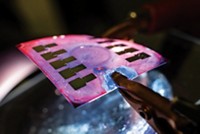Advertisement
Grab your lab coat. Let's get started
Welcome!
Welcome!
Create an account below to get 6 C&EN articles per month, receive newsletters and more - all free.
It seems this is your first time logging in online. Please enter the following information to continue.
As an ACS member you automatically get access to this site. All we need is few more details to create your reading experience.
Not you? Sign in with a different account.
Not you? Sign in with a different account.
ERROR 1
ERROR 1
ERROR 2
ERROR 2
ERROR 2
ERROR 2
ERROR 2
Password and Confirm password must match.
If you have an ACS member number, please enter it here so we can link this account to your membership. (optional)
ERROR 2
ACS values your privacy. By submitting your information, you are gaining access to C&EN and subscribing to our weekly newsletter. We use the information you provide to make your reading experience better, and we will never sell your data to third party members.
Materials
Designer Porous Carbon Could Boost Electrochemical Storage
Materials: An ordered hydrogel leads to highly porous carbon with desirable electronic properties
by Neil Savage
June 8, 2015
Using a new method, scientists have made a porous graphitic carbon with record-high surface area and triple the electrical conductivity of similar carbon materials (ACS Cent. Sci. 2015, DOI: 10.1021/acscentsci.5b00149). The new graphitic carbon could be used in electrochemical energy storage devices, such as supercapacitors and battery electrodes.


For use in such devices, porous materials need to provide lots of adsorption sites for ions. A large number of microsized pores means a higher surface area, and thus a higher capacity to store electricity. What’s more, when the pores interconnect, ions pass more easily through the material, improving its ability to transport ions in an electrolyte to the electrode surface. One candidate electrode material is graphitic carbon, but it is typically made by carbonizing biological material, such as coconut husks and eggshells, and the resulting carbon has pores with bad interconnectivity. Zhenan Bao of Stanford University and colleagues overcame this problem by synthesizing a precursor for their carbon material that already had its molecules arranged in their desired order.
They first created a hydrogel by mixing an aniline monomer, an ammonium persulfate oxidizing agent, and a phytic acid cross-linker. They then freeze-dried the hydrogel to remove the water, leaving behind an aerogel with well-interconnected pores. Heating the aerogel to 600 °C in a nitrogen atmosphere began carbonizing the material while the phytic acid helped maintain its pore structure. Then, raising the temperature to 800 °C burned away the phytic acid and completed carbonization. After etching with potassium hydroxide, the resulting graphitic carbon had a surface area of 4,073 m2 per gram and more than three times the electrical conductivity of conventional activated carbon. Bao’s team used the material to create and test high-performance supercapacitors.
Bao says starting with different reactants or altering the processing temperature could allow them to tune the porosity of the final material to a particular application. Their graphitic carbon might also be used as a catalyst in fuel cells or as a sorbent to capture carbon dioxide, she says.





Join the conversation
Contact the reporter
Submit a Letter to the Editor for publication
Engage with us on Twitter